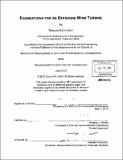Foundations for an offshore wind turbine
Author(s)
Kopp, Duncan Rath
DownloadFull printable version (19.63Mb)
Other Contributors
Massachusetts Institute of Technology. Dept. of Civil and Environmental Engineering.
Advisor
Andrew J. Whittle.
Terms of use
Metadata
Show full item recordAbstract
Worldwide energy demand is growing rapidly, and there is great interest in reducing the current reliance on fossil fuels for uses such as power generation, transportation, and manufacturing. Renewable energy sources, such as solar and wind, are abundant but have very low power densities. The US is in the process of approving its first offshore wind farm, located in Nantucket Sound. Geotechnical factors will play a large role in the development of offshore wind projects due to the high cost contribution from foundations, and the high loads associated with storm conditions. Offshore wind turbine foundations provide unique design challenges. First, various foundation alternatives exist, so it is important that an appropriate cost-effective foundation type be selected. Second, the loads and soil conditions will vary for each location. Therefore, it is important to ensure the foundation can adequately support vertical and horizontal loads. Finally, each turbine manufacturer has unique deflection and rotation criteria. Therefore, the foundation should perform within those tolerances, even under worst-case loading. This thesis considers the performance of a monopile foundation under typical vertical and horizontal storm loading conditions. Capacity, deflection, and rotation of a proposed monopile foundation are calculated by various methods to simulate the design procedure. The results show that very stiff foundations are required to keep pile head movements within design tolerances.
Description
Thesis (M. Eng.)--Massachusetts Institute of Technology, Dept. of Civil and Environmental Engineering, 2010. Cataloged from PDF version of thesis. Includes bibliographical references (p. 75-76).
Date issued
2010Department
Massachusetts Institute of Technology. Department of Civil and Environmental EngineeringPublisher
Massachusetts Institute of Technology
Keywords
Civil and Environmental Engineering.